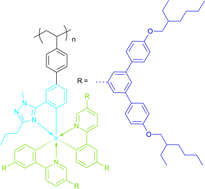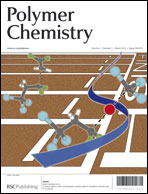The addition of dendrons to iridium(III) complexes attached to a poly(styrene) backbone is shown to improve the physical and optoelectronic properties of the phosphorescent materials. The iridium(III) complexes have two 2-phenylpyridyl ligands and one phenyltriazolyl ligand, with the latter providing the attachment point to the polymer backbone. It was found that by increasing the number of dendrons (from zero to two) per 2-phenylpyridyl ligand, the intra- and interchain interactions could be more effectively controlled. The poly(dendrimer) with two dendrons per ligand had solution and solid-state photoluminescence quantum yields of 67% and 47%, respectively. Organic light-emitting diodes containing the doubly dendronised (two dendrons per ligand) poly(dendrimer) had a low turn on voltage of 3.6 V (>1.0 cd m−2), a maximum luminance of 6 700 cd m−2 (at 12.2 V), and 100 cd m−2 was achieved at 6.0 V with an external quantum efficiency (EQE) of 9.2% (28.1 cd A−1) and power efficiency of 14.7 lm/W. A solution of the doubly dendronised poly(dendrimer) in N-methyl-2-pyrolidinone was found to have a viscosity of 4.6 mPa s, which falls in the range of solutions that can be inkjet printed.

You have access to this article
 Please wait while we load your content...
Something went wrong. Try again?
Please wait while we load your content...
Something went wrong. Try again?


 Please wait while we load your content...
Please wait while we load your content...